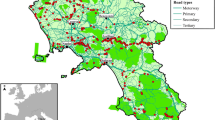Abstract
The wilderness travel simulation model estimates complex recreation use patterns in park and wilderness environments. The model was applied to a section of the Appalachian Trail in Vermont, a linear, long-distance, multiple-access trail system characteristic of the eastern United States. Many portions of the trail, including the study area, are now experiencing high use. The model estimated the average number of trail encounters per party day to be 3.3 and the average number of camp encounters per party night to be 2.3. Other measures of recreation use were also estimated that should prove useful to trail management and administration. Three trail management scenarios were tested, providing several preliminary insights to managers: the desirability of use redistributions as opposed to across-the-board reductions and needed emphasis on spatial use patterns and campsite encounters. Only minor modifications to the program were needed in applying the model to the trail environment and the model functioned accurately according to the validity tests performed.
Similar content being viewed by others
Literature Cited
Bloomers, P., and E. F. Lindquist. 1960. Elementary statistical methods. Houghton-Mifflin, Boston.
Burch, W. R., Jr. (ed.). 1979. Long distance trails: the Appalachian Trail as a guide to future research and management needs. Yale University, New Haven. 168 pp.
Colvin, R. B., and B. Shelby. 1979. The perception problem in crowding research: reported versus actual encounters. Paper presented at the annual meeting of the Rural Sociological Society, Burlington, VT.
Emshoff, J. R., and R. L. Sisson. 1970. Design and use of computer simulation models. MacMillan, New York.
Green Mountain Club. 1977. Guide book of the Long Trail. Queen City Press, Burlington, VT.
Lime, D. W., D. H. Anderson, and S. F. McCool. 1978. An application of the simulator to a river recreation setting. Pages 153–174in M. Shechter and R. D. Lucas (eds.), Simulation of recreational use for park and wilderness management. Johns Hopkins University Press for Resources for the Future, Baltimore.
Manning, R. E. 1979. Impacts of recreation on riparian soils and vegetation.Water Resources Bulletin 15:30–43.
McCool, S. F., D. W. Lime, and D. H. Anderson. 1977. Simulation modeling as a tool for managing river recreation. Proceedings of the river recreation management and research symposium. USDA Forest Service General Technical Report NC-28.
Miller, O. R. 1975. Recent developments in approaches to validation of simulation models. Paper presented to the Operations Research Society, Las Vegas.
Murray, J. B. 1974. Appalachian Trail users in the southern national forests: their characteristics, attitudes and management preferences. USDA Forest Service Research Paper SE-116, SE Forest Experimental Station, Asheville, NC.
Naylor, T. H., and J. M. Finger. 1967. Verification of computer simulation models.Management Science 14:92–106.
Plumley, H. J., H. T. Peet, and R. E. Leonard. 1978. Records of backcountry use can assist trail managers. USDA Forest Service Research Paper NE-414, NE Forest Experimental Station Durham, NH.
Schechter, M. 1975. Simulation model of wilderness area use: model-user's manual and program documentation. Resources for the Future, Washington, DC.
Shechter, M., and R. D. Lucas. 1978. Simulation of recreational use for park and wilderness management. Johns Hopkins Press for Resources for the Future Baltimore.
Smith, K. V. and R. L. Headly. 1975. The use of computer simulation models in wilderness management.In S. Ladany (ed.), Management science applications to leisure time, Amsterdam North-Holland, Amsterdam.
Smith, V. K., and J. V. Krutilla. 1974. A simulation model for management of low density recreational areas.Journal of Environmental Economics and Management 1:187–201.
Smith, V. K., and J. V. Krutilla. 1976. Structure and properties of a wilderness travel simulator: an application to the Spanish Peaks Area. Johns Hopkins University Press for Resources for the Future, Baltimore.
Stankey, G. H., R. C. Lucas, and D. W. Lime. 1976. Crowding in parks and wilderness.Design and Environment 7:38–41.
Author information
Authors and Affiliations
Rights and permissions
About this article
Cite this article
Potter, F.I., Manning, R.E. Application of the wilderness travel simulation model to the Appalachian Trail in Vermont. Environmental Management 8, 543–550 (1984). https://doi.org/10.1007/BF01871580
Issue Date:
DOI: https://doi.org/10.1007/BF01871580




